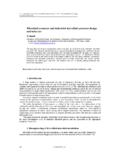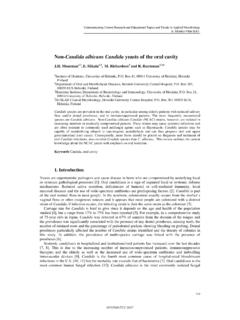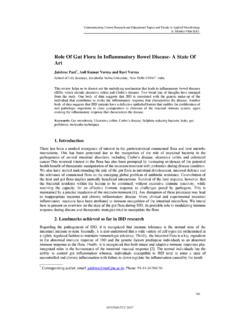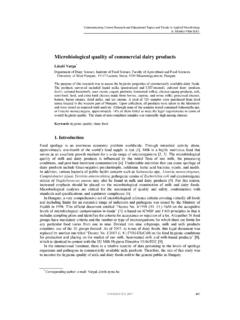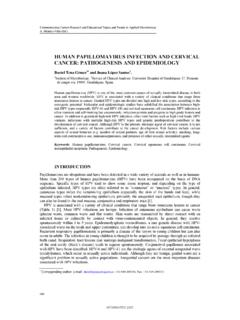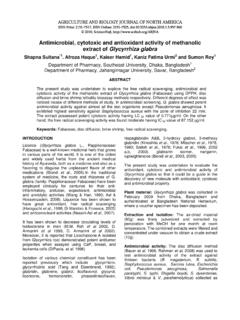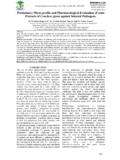Transcription of Different strategies for purification of antimicrobial ...
1 Communicating Current Research and Educational Topics and Trends in Applied Microbiology A. M ndez-Vilas (Ed.). _____. Different strategies for purification of antimicrobial peptides from Lactic Acid Bacteria (LAB). E. Vera Pingitore, E. Salvucci, F. Sesma, and M. E. Nader-Mac as*. Centro de Referencia para Lactobacilos (CERELA-CONICET), Chacabuco 145 (4000) San Miguel de Tucum n, Tucum n, Argentina Bacteriocins are natural peptides secreted by several bacteria that exert bactericidal activity against other bacterial species. Research in this topic is promoted not only by the need to develop alternatives to antibiotics and drugs that have shown non-desirable effects, but also to the capacity of some bacteriocin to inhibit saprophytic and food-borne pathogens in food stuffs. Many LAB are bacteriogenics, and the purification of the bacteriocins produced is helpful for the knowledge of the mechanism of action, structure, and other characteristics, which helps to isolate the bacteriocin biosynthetic genes.
2 In this chapter, Different techniques applied to purify some bacteriocins from LAB are described. The most frequently applied techniques involve salt precipitation followed by various combinations of ion-exchange (IEC) and reverse phase C18 solid phase extraction, absorption-desorption (AD), reverse-phase high- performance liquid chromatography (RP-HPLC) and Sodium Dodecyl Sulphate Polyacrilamide Gel Electrophoresis (SDS PAGE). The results obtained through the purification of Different LAB bacteriocins (enterocin and salivaricin) carried out in our laboratory are included to discuss the Different purification strategies applied. Keywords: bacteriocin, purification , Lactic acid bacteria, Lactobacillus, Enterococcus 1. Introduction Microbes compete for the limited space and nutrients present in natural ecological niches, therefore they have developped several strategies in order to survive: production of antimicrobial agents such as bacteriocins is one of them.
3 Gram-positive bacteria, and mainly lactic acid bacteria (LAB), are now being increasingly studied for their production of bacteriocin-like substances [1]. Bacteriocins are ribosomally synthesized antimicrobial peptides widely distributed in nature. This peptide biodiversity is supported by several differences in their structures. All constitutively synthesized peptides, regardless of sub-classification, share a net positive charge which causes them to fold into an amphiphilic conformation upon interaction with bacterial membranes [2]. Most characterized bacteriocins are heat-stable, nontoxic, and susceptible to degradation by proteolytic enzymes present in the gastrointestinal tract [3]. The increased consumption of foods containing additives formulated with chemical preservatives and consumer concerns have created a higher demand for more natural and minimally processed foods, therefore, there is a high interest in naturally produced antimicrobial agents that do not produce adverse effects.
4 This interest and also the potential applications in health care sectors have attracted the interest of academia and industry resulting in increased numbers of published research on bacteriocin production, purification , genetics, and applications. Adequate purification of bacteriocins is necessary for their characterization. The elucidation of their biochemical structure requires a pure, homogeneous peptide as well as an adequate yield of protein. A. *. Corresponding author: Dr. Mar a Elena Nader-Mac as, CERELA-CONICET, Chacabuco 145, de Tucum n (4000), Argentina, Tel: +54-381-4310465. 557. FORMATEX 2007. Communicating Current Research and Educational Topics and Trends in Applied Microbiology A. M ndez-Vilas (Ed.). _____. rapid, reliable, quantitative and sensitive method for detection of bacteriocins became essential in the search for new alternatives with potential industrial applications.
5 Based on the heterogenous nature of bacteriocins a general method or protocol is not available [1], and a wide range of methodologies for the purification Lactic Acid Bacteria (LAB) and related microorganisms bacteriocins have been described, as resumed in Table 1. Table 1. Bacteriocins from LAB and related microorganisms. Some aspects of their purification Ste Bacteriocin purification Yield Ref ps Ammonium sulfate precipitation - Sep-pack C18. Plantaricin 3 cartridge RP-HPLC [4]. ST31. Cation exchange Chromatography 1 Expanded bed, Nisin Z 1 90% [5]. Ion-exchange chromatography (EB-IEC). Enterocin AS48 Cation exchange Reverse Phase Chromatography 2 [3]. Plantaricin C19 Adsorption/release RP-HPLC 2 15% [6]. Pediocin ACM Adsorption-desorption RP-HPLC 2 40,4% [7]. Salivaricin Ammonium sulfate precipitation C18 2 7,3% This work Unnamed Ammonium sulfate Tricholoroacetic acid - 3 [8].
6 Bacteriocins Precipitation - Ultrafiltration Pediocin PA-1 Etanol precipitation - Isoelectric focusing 3 29. [9]. Lactococcin B - Ultrafiltration 3 41. Mesentericin 3 60%. Y105. Sakacin A 3 10%. [10]. Sakacin P Cation exchange chromatography C18 HPLC 3 10%. Enterocin A 3 66%. Pediocin A-1 3 25%. Divercin V41 3 10%. Acidocin Ammonium sulphate precipitation - Cation exchange [11]. 3 16%. D20079 chromatography - Octyl Sepharose column. Acetone precipitation - Cation exchange Lacticin Q 3 64% [12]. chromatography RP-HPLC. Ammonium sulfate precipitation - Chloroform- Lactobin A 3 0,07% [13]. methanol extraction - RP-FPLC. Divergicin M35 Cation exchange chromatography - Sep-Pack C18 - RP- [14]. 3 10%. HPLC. Ammonium sulfate precipitation - Molecular filtration Enterocin Biogel P-6 - 4 2% [15].
7 CRL35. Cation exchange chromatography - HPLC. Ammonium sulfate precipitation Sep-Pack C18 RP- [16]. Bozacin 14 4 HPLC. Mutacin B- C18 column - HPLC (x3) 4 % [17]. Ny266. Ammonium sulfate precipitation - Hydrophobic 6,4%. Abp118 interaction - Cation exchange chromatography C8/C18 4 [18]. RP-FPLC. Ammonium sulfate precipitation - Anion exchange Macedocin [19]. chromatography - Cation exchange chromatography - 5 1,6%. Reverse-phase chromatography - Gel filtration 558. FORMATEX 2007. Communicating Current Research and Educational Topics and Trends in Applied Microbiology A. M ndez-Vilas (Ed.). _____. Ammonium sulfate precipitation - Cation exchange Michiganin A [20]. chromatography - RPC column - pepRPC HR 5/5 5 3%. column - RPC C2/C18 column. Piscicocin Ammonium sulfate precipitation - gel-filtration - cation [21].
8 CS526 5 7%. exchange chromatography - C18 cartridge - RP-HPLC. Ammonium sulphate precipitate - Anion-exchange [22]. Propionicin F 5 0,5%. chromatography - Reverse-phase chromatography (x3). Ammonium sulphate precipitation dialyses . [23]. Pediocin PD-1 lyophilization methanol chloroform extraction 6 34%. cation exchange. In this chapter, some strategies implemented in our laboratory for the purification of bacteriocins are described using two Different antimicrobial compounds as models: salivaricin CRL1328, and enterocin CRL35. Lactobacillus (Lb.) salivarius CRL1328 is a probiotic microorganism isolated from the vagina of a healthy woman [24]. Ths strain produces a bacteriocin, named salivaricin CRL1328 which was characterized preliminarily, and was the first bacteriocin described as being produced by a vaginal isolate [24].
9 Recently, the salivaricin biosynthesis genes have been characterized (data not shown, Genbank accesion number AF592482). This bacteriocin resulted to be a two component bacteriocin (class IIb). identical to the bacteriocin described by Flynn et al. [18] produced by Lb. salivarius UCC118 of intestinal origin. On the other hand, enterocin CRL35 is produced by Enterococcus (E.) mundtii CRL35, isolated from an artisanal cheese [15]. Enterocin is a class IIa bacteriocin [15],[25]. 2. Protocols for bacteriocins purification Culture media. The composition of the growth medium greatly affects the production of individual bacteriocins [26]. Several media have been evaluated by numerous authors to improve bacteriocin synthesis [27], because these peptides are not always produced in standard or enriched culture media.
10 Lactic acid bacteria are fastidious microorganisms that require rich media containing milk, whey ultrafiltrate, or complex synthetic media such as MRS [28], M17 [29] or LAPTg [30] for growth. Therefore, the isolation of a peptide(s) in rich-medium supernatant is an additional problem, making the purification of the bacteriocin a relatively complicated protocol. Furthermore, many bacteriocin molecules tend to associate with other substances present in the culture medium, where they can display a high degree of hydrophobicity and form protein aggregates. In this sense, a chemically defined medium (CDM) which allows the growth and bacteriocin production by LAB would be be very useful for determining the influence of Different nutrients on bacteriocin production and for an easy and efficient downstream processing.

